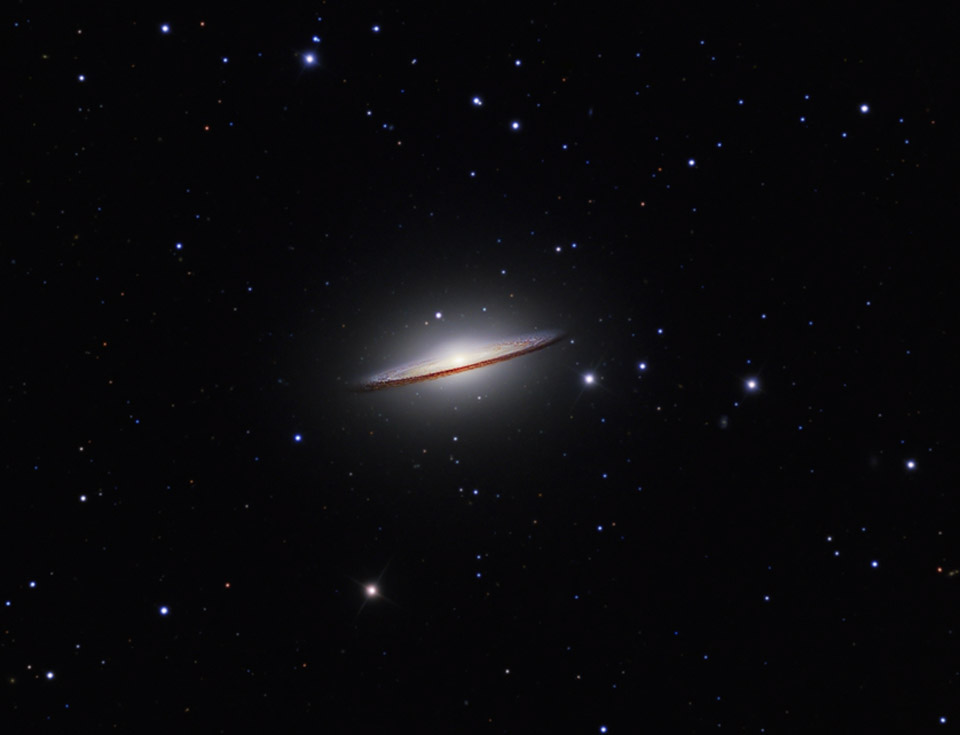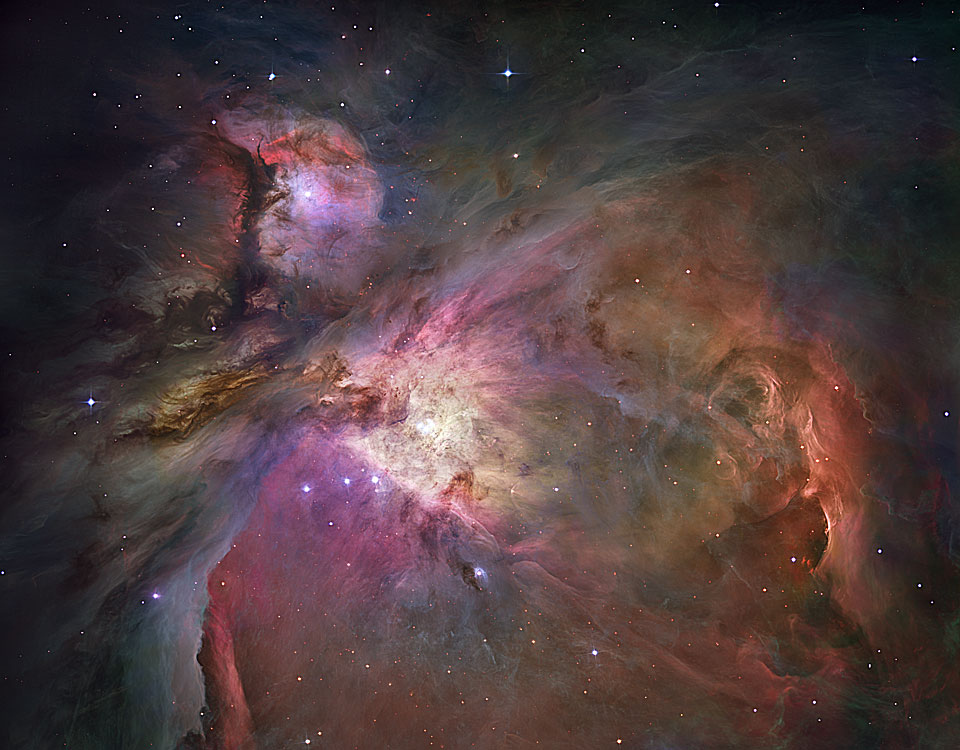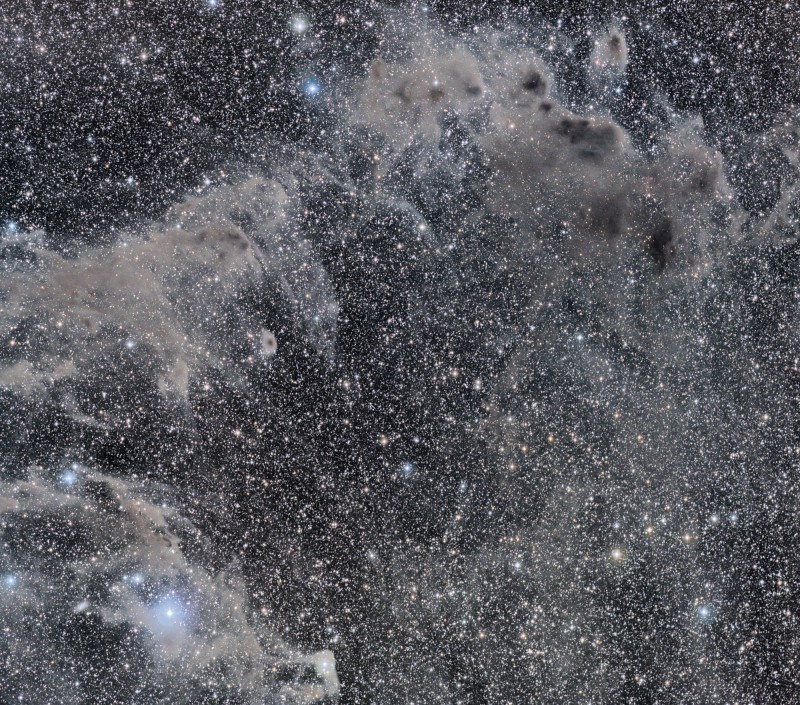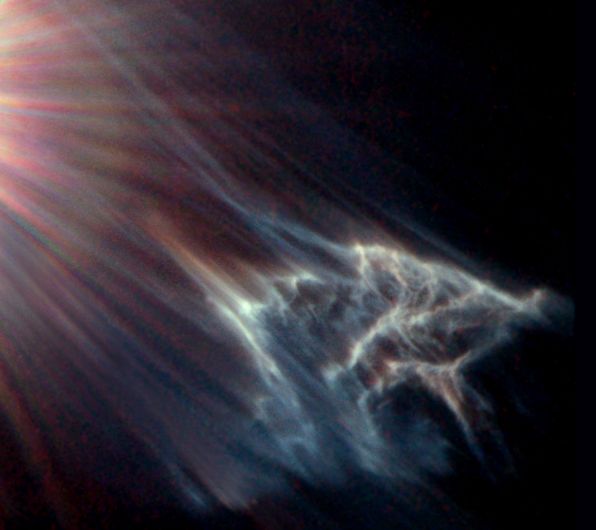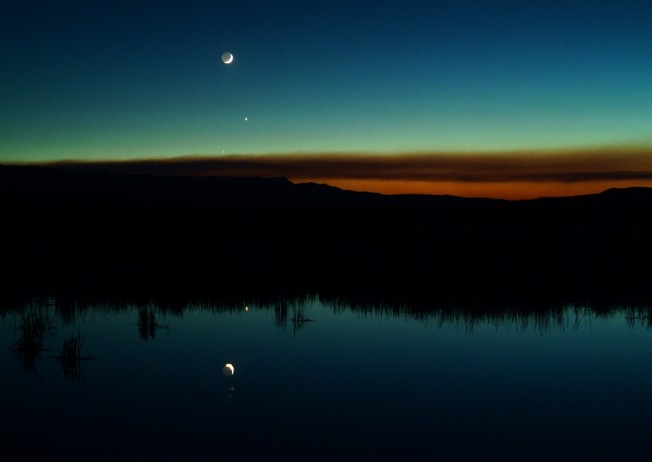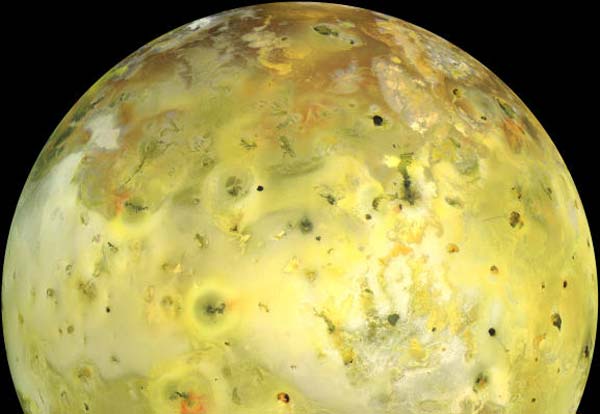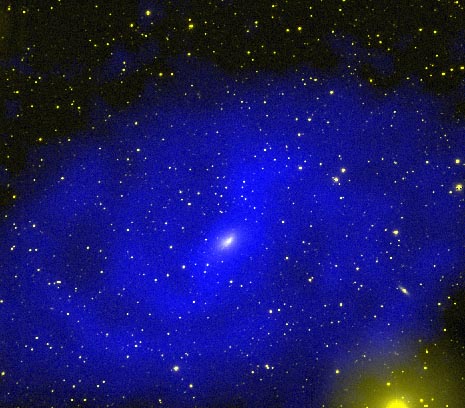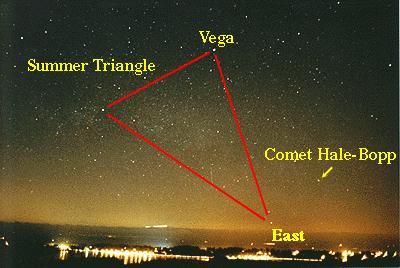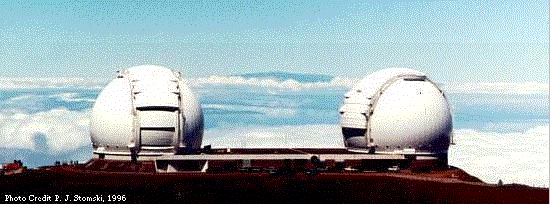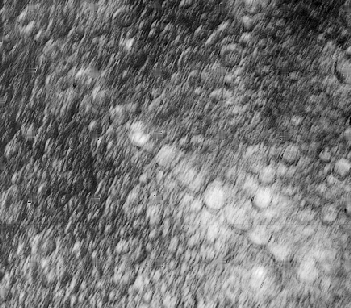| << Previous | Index | Next >> |
2015 New Horizons has survived its close encounter with Pluto and has resumed sending back images and data. The robotic spacecraft reported back on time, with all systems working, and with the expected volume of data stored. Featured here is the highest resolution image of Pluto taken before closest approach, an image that really brings Pluto into a satisfying focus. At first glance, Pluto is reddish and has several craters. Toward the image bottom is a surprisingly featureless light-covered region that resembles an iconic heart, and mountainous terrain appears on the lower right. This image, however, is only the beginning. As more images and data pour in today, during the coming week, and over the next year, humanity's understanding of Pluto and its moons will likely become revolutionized.
2014
2013
2012 Few cosmic vistas excite the imagination like the Orion Nebula. Also known as M42, the nebula's glowing gas surrounds hot young stars at the edge of an immense interstellar molecular cloud only 1,500 light-years away. The Orion Nebula offers one of the best opportunities to study how stars are born partly because it is the nearest large star-forming region, but also because the nebula's energetic stars have blown away obscuring gas and dust clouds that would otherwise block our view - providing an intimate look at a range of ongoing stages of starbirth and evolution. This detailed image of the Orion Nebula is the sharpest ever, constructed using data from the Hubble Space Telescope's Advanced Camera for Surveys and the European Southern Observatory's La Silla 2.2 meter telescope. The mosaic contains a billion pixels at full resolution and reveals about 3,000 stars.
2011 NGC 3314 is actually two large spiral galaxies which just happen to almost exactly line up. The foreground spiral is viewed nearly face-on, its pinwheel shape defined by young bright star clusters. But against the glow of the background galaxy, dark swirling lanes of interstellar dust appear to dominate the face-on spiral's structure. The dust lanes are surprisingly pervasive, and this remarkable pair of overlapping galaxies is one of a small number of systems in which absorption of light from beyond a galaxy's own stars can be used to directly explore its distribution of dust. NGC 3314 is about 140 million light-years (background galaxy) and 117 million light-years (foreground galaxy) away in the multi-headed constellation Hydra. The background galaxy would span nearly 70,000 light-years at its estimated distance. A synthetic third channel was created to construct this dramatic new composite of the overlapping galaxies from two color image data in the Hubble Legacy Archive.
2010 On July 11, after a long trek eastward across the southern Pacific Ocean, the Moon's shadow reached landfall in South America. In a total solar eclipse close to sunset, silhouetted Moon and Sun hugged the western horizon, seen here above the Andes mountains near the continent's southern tip. To enjoy a good vantage point, the photographer hiked to a windy spot about 400 meters above a lake, Lago Argentino, climbing into the picture after setting up his camera on a tripod. At left, the sky outside the shadow cone is still bright. Below, the lights of El Calafate, Patagonia, Argentina, shine by the lake shore.
2009 The Chameleon is a small constellation near the south celestial pole. Boasting no bright stars, it blends inconspicuously with the starry southern sky. But, taken in dark skies over Namibia, this image reveals a stunning aspect of the shy constellation -- a field of dusty nebulae and colorful stars. Blue reflection nebulae are scattered through the scene, but most eye-catching is the complex of silvery dust clouds that only faintly reflect starlight, punctuated by dense dark nebulae. The dark nebulae stand out because they block out background stars. This view of the cosmic dust clouds spans about 4 degrees on the sky.
2008 This beautiful cosmic cloud is a popular stop on telescopic tours of the constellation Sagittarius. Eighteenth century cosmic tourist Charles Messier cataloged the bright nebula as M8, while modern day astronomers recognize the Lagoon Nebula as an active stellar nursery about 5,000 light-years distant, in the direction of the center of our Milky Way Galaxy. Striking details can be traced through this remarkable picture, processed to remove stars and hence better reveal the Lagoon's range of filaments of glowing hydrogen gas, dark dust clouds, and the bright, turbulent hourglass region near the image center. This color composite view was recorded under dark skies near Sydney, Australia. At the Lagoon's estimated distance, the picture spans about 50 light-years.
2007 From the ground, spectacular auroras seem to dance high above. But the International Space Station (ISS) orbits at nearly the same height as many auroras, sometimes passing over them, and sometimes right through them. Still, the auroral electron and proton streams pose no direct danger to the ISS. In 2003, ISS Science Officer Don Pettit captured the green aurora, pictured above in a digitally sharpened image. From orbit, Pettit reported that changing auroras appeared to crawl around like giant green amoebas. Over 300 kilometers below, the Manicouagan Impact Crater can be seen in northern Canada, planet Earth.
2006 In the well known Pleiades star cluster, starlight is slowly destroying this wandering cloud of gas and dust. The star Merope lies just off the upper left edge of this picture from the Hubble Space Telescope. In the past 100,000 years, part of the cloud has by chance moved so close to this star - only 3,500 times the Earth-Sun distance - that the starlight itself is having a very dramatic effect. Pressure of the star's light significantly repels the dust in the reflection nebula, and smaller dust particles are repelled more strongly. As a result, parts of the dust cloud have become stratified, pointing toward Merope. The closest particles are the most massive and the least affected by the radiation pressure. A longer-term result will be the general destruction of the dust by the energetic starlight.
2005 Only Mars is missing from this reflective view of the major rocky bodies of the inner solar system. Captured on July 8th, the serene, twilight picture looks out over the Flat Tops Wilderness area from near Toponas, Colorado, USA and includes planets Mercury, Venus, Earth, and Earth's large natural satellite, the Moon. The Moon is in a young crescent phase about three degrees above bright planet Venus. Forest fires contribute to a layer of smoke in Earth's sky that almost hides planet Mercury, still visible very near the horizon. Just a week earlier Venus and Mercury were joined by Saturn, forming a notable grouping in the west also enjoyed by skygazers across planet Earth.
2004 A cosmic dust cloud sprawls across a rich field of stars in this gorgeous wide field telescopic vista looking toward Corona Australis, the Southern Crown. Probably less than 500 light-years away and effectively blocking light from more distant, background stars in the Milky Way, the densest part of the dust cloud is about 8 light-years long. At its tip (lower left) is a series of lovely blue nebulae cataloged as NGC 6726, 6727, 6729, and IC 4812. Their characteristic blue color is produced as light from hot stars is reflected by the cosmic dust. The tiny but intriguing yellowish arc visible near the blue nebulae marks young variable star R Coronae Australis. Magnificent globular star cluster NGC 6723 is seen here below and left of the nebulae. While NGC 6723 appears to be just outside Corona Australis in the constellation Sagittarius, it actually lies nearly 30,000 light-years away, far beyond the Corona Australis dust cloud.
2003 Mars is heading for its closest encounter with Earth in over 50,000 years. Although Mars and Earth continue in their normal orbits around the Sun, about every two years Earth and Mars are on the same part of their orbit as seen from the Sun. When this happens again in late August, Mars will be almost as near to the Sun as it ever gets, while simultaneously Earth will be almost as far from the Sun as it ever gets. This means that now is a great time to launch your space probe to Mars. Alternatively, these next few months are a great time to see a bright red Mars from your backyard. Mars is so close that global features should be visible even through a small telescope. Look for Mars to rise about 11 pm and to remain the brightest red object in the sky until sunrise. Mars will rise increasingly earlier until its closest approach in late August. Mars was captured above rising through the Arch Rock in Valley of Fire State Park, Nevada, USA.
2002 What is the closest star to our Sun? It is Proxima Centauri, the nearest member of the Alpha Centauri triple star system. Light takes only 4.22 years to reach us from Proxima Centauri. This small red star, captured in the center of the above image, is so faint that it was only discovered in 1915 and is only visible through a telescope. Stars of all types from our Milky Way Galaxy are visible in the background. The brightest star in the Alpha Centauri system is quite similar to our Sun, has been known as long as recorded history, and is the third brightest star in the night sky. The Alpha Centauri system is primarily visible from Earth's Southern Hemisphere.
2001 The strangest moon in the Solar System is bright yellow. This picture, showing Io's true colors, was taken in 1999 July by the Galileo spacecraft currently orbiting Jupiter. Io's colors derive from sulfur and molten silicate rock. The unusual surface of Io is kept very young by its system of active volcanoes. The intense tidal gravity of Jupiter stretches Io and damps wobbles caused by Jupiter's other Galilean moons. The resulting friction greatly heats Io's interior, causing molten rock to explode through the surface. Io's volcanoes are so active that they are effectively turning the whole moon inside out. Some of Io's volcanic lava is so hot it glows in the dark.
2000 As the Earth spins on its axis, the stars seem to rotate around us. This motion produces the beautiful concentric arcs traced out by the stars in this time exposure of the southern hemisphere night sky. In the foreground is the dome of the Anglo-Australian Telescope in central New South Wales, Australia. In the middle of the picture is the South Celestial Pole, the projection of Earth's axis of rotation into the southern sky. While the bright star Polaris lies conveniently close to the North Celestial Pole, no bright star similarly marks the pole in the south. Still, the South Celestial Pole is easily identified in the picture as the point in the sky at the center of all the star trail arcs.
1999 Known for his sense of humor and infectious grin, Charles P. "Pete" Conrad, as commander of the Apollo 12 mission, was the third person to walk on the moon. Not a tall man, Conrad stepped down onto the lunar surface in November of 1969 and gleefully commented, "Whoopie! Man, that may have been a small one for Neil, but that's a long one for me." Born June 2nd, 1930 in Philadelphia, Pennsylvania, he graduated from Princeton University in 1953 and went on to become a Navy test pilot. Selected as a NASA astronaut in 1962, Conrad is seen here in 1965 during a suiting up activity in preparation for his first space flight - the endurance record setting Gemini 5 mission. His final space flight was to Skylab in 1973. Tragically, Conrad died from injuries in a motorcycle accident on Thursday, July 8.
1998
1997 Vega is a bright blue star 25 light years away. Vega is the brightest star in the Summer Triangle, a group of stars easily visible summer evenings in the northern hemisphere. The name Vega derives from Arabic origins, and means "stone eagle." 4,000 years ago, however, Vega was known by some as "Ma'at" - one example of ancient human astronomical knowledge and language. 14,000 years ago, Vega, not Polaris, was the north star. Vega is the fifth brightest star in the night sky, and has a diameter almost three times that of our Sun. Life bearing planets, rich in liquid water, could possibly exist around Vega. The above picture, taken in January, finds Vega, the Summer Triangle, and Comet Hale-Bopp high above Victoria, British Columbia, Canada.
1996 In buildings eight stories tall rest mirrors ten meters across that are slowly allowing humanity to map the universe. Alone, each is the world's largest optical telescope: Keck. Together, the twin Keck telescopes have the resolving power of a single telescope 90-meter in diameter, able to discern sources just milliarcseconds apart. Since opening in 1992, the real power of Keck I (left) has been in its enormous light-gathering ability - allowing astronomers to study faint and distant objects in our Galaxy and the universe. Keck II, completed earlier this year, and its twin are located on the dormant volcano Mauna Kea, Hawaii, USA. In the distance is Maui's volcano Haleakala. One reason Keck was built was because of the difficultly for astronomers to get funding for a smaller telescope.
1995 NASA's robot spaceprobe Voyager 1, took this closeup image of the surface of Jupiter's crater scarred moon Callisto in 1979. A mysterious chain of craters is seen to extend diagonally across the image (upper left to lower right). What could cause the craters to line up in such a regular fashion? Scientists were at a loss to explain this crater chain along with several other chain like features observed on Callisto's surface. Fifteen years later, with the discovery of Comet Shoemaker-Levy 9, also known as the "string of pearls" comet, the mystery was solved. Comets whose orbits stray too close to Jupiter are torn apart by the strong gravity. When the individual pieces, strung out along the orbital path of the comet hit an object like Callisto, the sequence of impacts produces a crater chain.
| << Previous | Index | Next >> |


